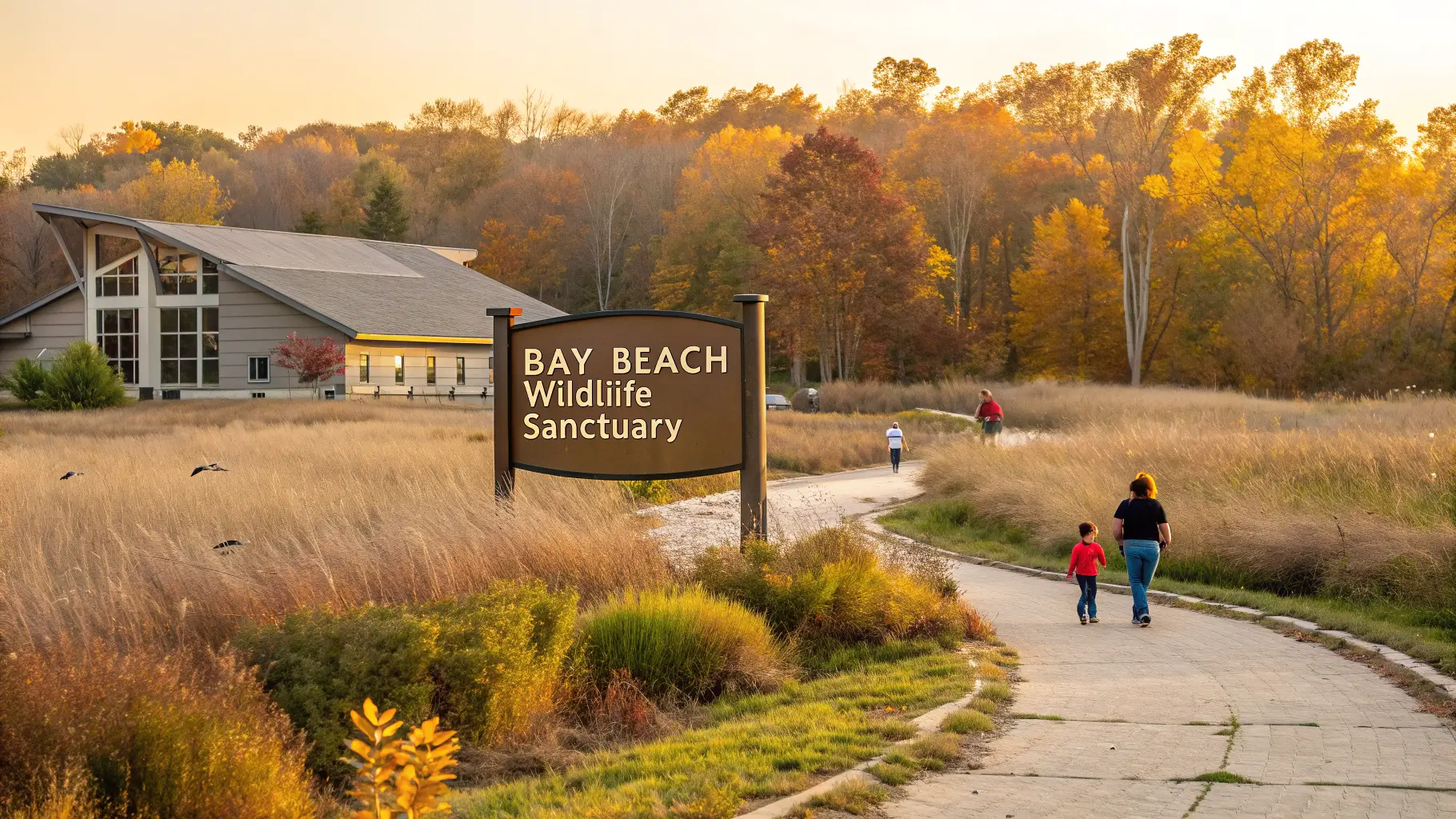Introduction
What makes Bay Beach Wildlife Sanctuary truly extraordinary? Imagine a place where urban life meets wild nature, where injured animals get a second chance at life, and where visitors can witness conservation in action. Located in Green Bay, Wisconsin, the Bay Beach Wildlife Sanctuary stands as one of the Midwest’s premier wildlife rehabilitation and education centers, offering a unique blend of natural beauty, conservation efforts, and educational opportunities that you won’t find anywhere else.
This comprehensive guide will take you through everything you need to know about visiting Bay Beach Wildlife Sanctuary: in 2025. Whether you’re a local resident who’s never stepped foot on the grounds or a nature enthusiast planning your first visit from out of state, we’ve got you covered. From the best times to spot specific wildlife to insider tips that even regular visitors might not know, this guide serves as your complete resource for making the most of your sanctuary experience.
Table of Contents
What is Bay Beach Wildlife Sanctuary?
History & Mission
The story of Bay Beach Wildlife Sanctuary begins in 1928 when it was first established as a waterfowl sanctuary. However, the sanctuary truly found its calling in the 1960s when it transformed into a comprehensive wildlife rehabilitation facility. What started as a simple refuge for migratory birds has evolved into a nationally recognized center for wildlife care, education, and conservation.
The sanctuary’s mission is beautifully threefold: to provide medical care and rehabilitation for injured and orphaned wildlife, to educate the public about the importance of wildlife conservation, and to preserve natural habitat for native species. This isn’t just a place where animals are displayed – it’s a working hospital, classroom, and conservation laboratory all rolled into one.
Over the decades, Bay Beach Wildlife Sanctuary has treated thousands of animals, from tiny hummingbirds to majestic eagles. The facility has pioneered rehabilitation techniques that are now used worldwide, making it a leader in wildlife medicine and conservation practices.
Unique Features & Significance
What sets Bay Beach Wildlife Sanctuary apart from other nature centers is its active role in wildlife rehabilitation. Unlike a zoo where you observe captive animals, here you’re witnessing real conservation in action. The sanctuary houses animals that are either recovering from injuries, permanently disabled and unable to be released, or serving as educational ambassadors for their species.
The facility operates one of Wisconsin’s premier wildlife hospitals, treating over 2,000 animals annually. Their veterinary staff and volunteers work tirelessly to provide medical care, physical therapy, and behavioral conditioning to help animals return to the wild. Those that cannot be released due to permanent disabilities find a permanent home at the sanctuary, where they play crucial roles in educational programs.
Conservation efforts extend beyond individual animal care. The sanctuary maintains critical habitat for native species, conducts research on local ecosystem health, and participates in species recovery programs. Their work with threatened species like the trumpeter swan has been instrumental in their recovery in Wisconsin.
Size, Layout Overview
Spanning approximately 700 acres, Bay Beach Wildlife Sanctuary: is a sprawling oasis of preserved wetlands, forests, and prairies. The facility is thoughtfully designed with accessibility in mind, featuring:
- The Nature Center: A modern 9,000-square-foot building housing exhibits, a theater, gift shop, and educational spaces
- Wildlife Hospital: A state-of-the-art medical facility (viewable during certain tours)
- Outdoor exhibits: Home to permanently disabled animals unable to be released
- Trail system: Over 6 miles of trails ranging from paved accessible paths to more rugged hiking trails
- Observation platforms: Strategically placed viewing areas for optimal wildlife watching
- Fox River frontage: Prime wetland habitat along the Fox River
The sanctuary’s layout follows the natural topography of the land, with trails meandering through diverse habitats including prairies, woodlands, marshes, and open water areas. Each area has been carefully managed to support different wildlife species and provide visitors with varied experiences.
Planning Your Visit
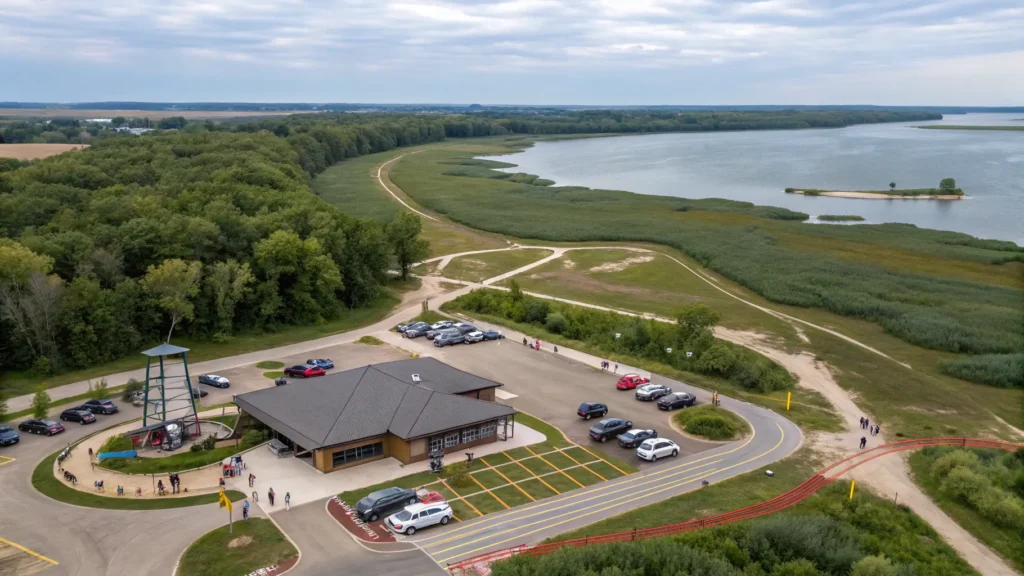
Getting There
Address: 1660 E Shore Dr, Green Bay, WI 54302
GPS Coordinates: 44.4738° N, 87.9919° W
Driving Directions:
- From Milwaukee: Take I-43 North to US-172 West, then follow signs to Bay Beach Wildlife Sanctuary
- From Madison: Take I-94 East to I-43 North, then US-172 West
- From Green Bay downtown: Head east on Webster Avenue, which becomes East Shore Drive
Public Transportation: Green Bay Metro Route 1 stops within walking distance of the sanctuary. The bus runs hourly on weekdays with limited weekend service.
Parking Information: The sanctuary offers ample free parking with:
- Main parking lot: 200+ spaces
- Overflow parking during peak times
- Designated accessible parking spaces
- RV and bus parking available
- Best spots: Arrive early for shaded parking near the nature center entrance
Hours & Admission
Current Hours (2025):
- January-March: Tuesday-Sunday, 8:00 AM – 5:00 PM
- April-October: Daily, 7:00 AM – 7:00 PM
- November-December: Daily, 8:00 AM – 5:00 PM
- Nature Center: Daily, 10:00 AM – 4:00 PM
- Closed: Thanksgiving, Christmas Day, New Year’s Day
Admission: FREE! The sanctuary is entirely free to visit, though donations are always welcome and greatly appreciated.
Special Holiday Hours:
- Memorial Day, Independence Day, Labor Day: Normal hours
- Christmas Eve: 8:00 AM – 2:00 PM
- New Year’s Eve: 8:00 AM – 2:00 PM
Important: Always check the official Wisconsin Department of Natural Resources page for the most up-to-date information on hours and any temporary closures due to weather or special events.
Best Times to Visit
By Season:
Spring (March-May)
- What to See: Migrating waterfowl, early wildflowers, active wildlife rehabilitation
- Highlights: Peak bird migration (April-May), baby animals born in captivity
- Weather: Variable, dress in layers
- Special Events: Spring bird walks, rehabilitation open houses
Summer (June-August)
- What to See: Full foliage, all outdoor exhibits active, summer bird species
- Highlights: Long daylight hours, perfect weather for hiking
- Peak Season: Expect more crowds, especially weekends
- Special Programs: Summer camp programs, evening nature walks
Fall (September-November)
- What to See: Fall migration, stunning autumn colors, waterfowl abundance
- Highlights: Peak foliage (early October), excellent photography conditions
- Benefits: Cooler temperatures, fewer crowds than summer
- Migration: Prime time for bird watching
Winter (December-February)
- What to See: Winter-adapted wildlife, ice formations, cross-country skiing
- Highlights: Peaceful, snowy landscapes, unique photo opportunities
- Indoor Focus: More time in the nature center, fewer outdoor exhibits accessible
- Special: Holiday-themed programs, winter ecology tours
By Day/Time:
Best Days: Tuesday-Thursday for fewer crowds, Saturday mornings for educational programs Early Morning (first hour after opening): Best for wildlife activity, peaceful atmosphere Late Afternoon (hour before closing): Good for photography, active feeding time for many animals Avoid: Holiday weekends and sunny weekend afternoons if you prefer solitude
Accessibility
Bay Beach Wildlife Sanctuary: is committed to being accessible to all visitors:
Wheelchair Accessibility:
- Fully accessible nature center with automatic doors
- Paved, level trails (approximately 1.5 miles of fully accessible paths)
- Accessible restrooms in the nature center and at trail locations
- Reserved parking spaces close to entrances
- Wheelchair-accessible viewing platform at the Fox River
Stroller-Friendly Features:
- Wide, paved pathways for easy navigation
- Benches and rest areas throughout
- Changing station in family restroom
- Stroller parking area in nature center
Additional Accessibility:
- Service animals welcome throughout the facility
- Large-print trail guides available
- Audio tours for visually impaired visitors
- Staff trained in accessibility assistance
- Golf cart tours available for mobility-impaired visitors (advance reservation required)
What to Bring
Essential Items:
- Comfortable walking shoes or hiking boots
- Weather-appropriate clothing (layers recommended)
- Drinking water (water stations available in nature center)
- Sunscreen and insect repellent (especially summer)
- Small backpack for carrying personal items
Recommended Gear:
- Binoculars (rentals available at nature center for $5)
- Camera with zoom lens for wildlife photography
- Field guide to Wisconsin birds/wildlife
- Notebook for nature journaling
- Folding chair for comfortable wildlife watching
Seasonal Considerations:
- Spring/Fall: Waterproof jacket, warm layers
- Summer: Sun hat, extra water, cooling towel
- Winter: Warm coat, waterproof boots, hand warmers
Food Policy: Outside food is permitted in designated picnic areas only. No glass containers allowed. Water and snacks available for purchase in nature center.
Rules & Regulations
For Everyone’s Safety:
- Stay on designated trails and pathways
- Do not feed any wildlife (this can make them sick or aggressive)
- Do not disturb resting or nesting animals
- Keep noise levels low to avoid stressing wildlife
- Do not pick plants or remove natural items
Photography Guidelines:
- Photography permitted throughout sanctuary
- No flash photography near animals
- Drone use prohibited without special permit
- Commercial photography requires advance permission
- Respectful distance must be maintained from all animals
Pet Policy:
- Pets are NOT allowed on sanctuary grounds
- Service animals are welcome
- Pet-friendly areas available in nearby parks
Volunteer Guidelines:
- All volunteers must complete orientation program
- Background checks required for certain positions
- Regular commitment expected
- No drop-in volunteering for wildlife care
Additional Rules:
- No smoking anywhere on grounds
- No alcohol or controlled substances
- Groups of 15+ require advance notification
- No bicycles, skateboards, or motorized vehicles on trails
Wildlife at the Sanctuary
White-Tailed Deer
White-tailed deer are among the most charismatic residents of Bay Beach Wildlife Sanctuary: The sanctuary is home to several permanently disabled deer that cannot be released back to the wild.
Fascinating Facts:
- Deer can jump fences up to 8 feet high
- They have scent glands that allow complex communication
- A deer’s coat changes color seasonally – reddish-brown in summer, grayish-brown in winter
- They can run up to 40 mph and are excellent swimmers
Best Viewing Times: Early morning (7-8 AM) and late afternoon (5-6 PM) Prime Locations: The meadow near the Fox River viewing platform and along the Woodland Trail
Conservation Story: The sanctuary has rehabilitated numerous deer over the years, treating everything from vehicle strikes to orphaned fawns. Their current residents serve as ambassadors for their species, helping visitors understand deer behavior and the challenges they face in urban environments.
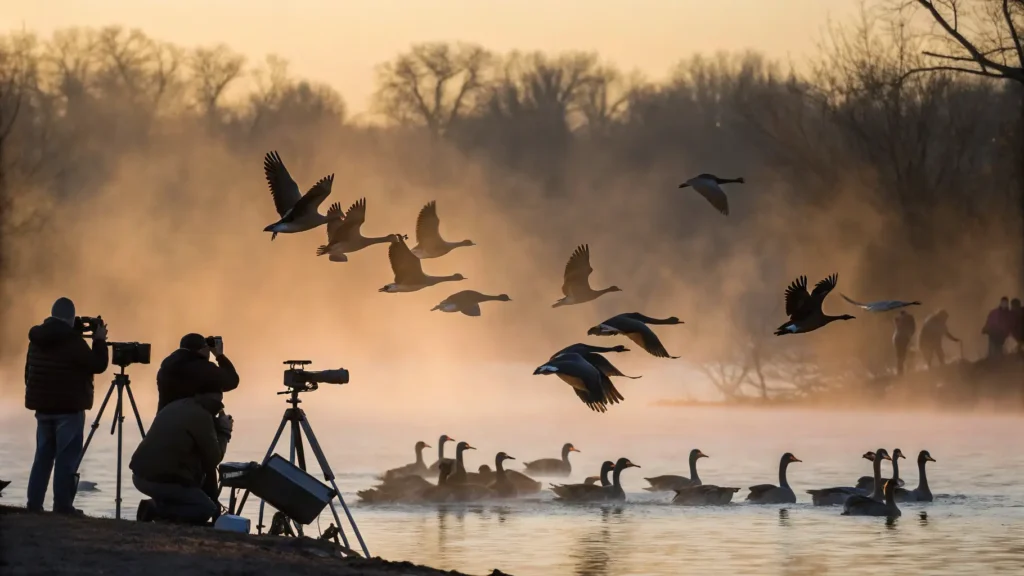
Waterfowl
Bay Beach Wildlife Sanctuary: is a crucial stopover point for migrating waterfowl, making it one of Wisconsin’s best waterfowl viewing destinations.
Species to Watch For:
- Canada Geese: Year-round residents and migration stars
- Mallards: The most recognizable ducks
- Wood Ducks: Stunning colors and unique nesting habits
- Blue-winged and Green-winged Teal: Small, fast ducks
- Trumpeter Swans: Wisconsin’s largest waterfowl (conservation success story)
Migration Timing:
- Spring: March-May (peak in April)
- Fall: September-November (peak in October)
- Winter: Ice-out viewing of cold-hardy species
Best Viewing Spots:
- Fox River Observation Platform
- Waterfowl viewing blind
- Wetland boardwalk
Raptors (Birds of Prey)
The sanctuary houses several permanently disabled raptors that play crucial roles in education programs.
Resident Raptors:
- Bald Eagles: Symbol of American conservation success
- Red-tailed Hawks: Most common hawk in Wisconsin
- Barred Owls: Known for their distinctive “who-cooks-for-you” call
- Great Horned Owls: Powerful nighttime predators
Fascinating Raptor Facts:
- Eagles can see 8 times better than humans
- Owls can rotate their heads 270 degrees
- A hawk’s eyeball is about the same size as a human’s
- Some raptors can dive at speeds over 200 mph
Viewing Tips:
- Morning flights are most active
- Look for soaring birds on warm, sunny afternoons
- Listen for owl calls at dawn and dusk
Wolves
Though not permanent residents, Bay Beach Wildlife Sanctuary: occasionally houses wolves during rehabilitation. Wisconsin’s wolf population has been a conservation success story.
Wolf Education:
- Wisconsin has approximately 800-900 wolves
- Wolves were extirpated from Wisconsin in 1960 and recolonized in the 1970s
- A single pack requires 50-100 square miles of territory
- Wolves play a crucial role in ecosystem balance
Viewing Opportunities:
- Special wolf education programs (when available)
- Interactive displays in nature center
- Guided tours discussing wolf conservation
Small Mammals
Fox Species:
- Red foxes and gray foxes occasionally seen on trails
- Both species adapt well to edge habitats
Beavers:
- Evidence of beaver activity along Fox River
- Chewed trees and lodges visible from boardwalk
Other Notable Species:
- Raccoons, opossums, and porcupines (mostly nocturnal)
- Various bat species active at dusk
- Chipmunks and ground squirrels throughout sanctuary
Things to Do & See
Trail System
Bay Beach Wildlife Sanctuary: offers over 6 miles of diverse trails, each providing unique experiences and wildlife viewing opportunities.
Woodland Trail
- Length: 0.8 miles (loop)
- Difficulty: Easy
- Highlights: Mature forest, spring wildflowers, deer habitat
- Accessibility: Partially paved, some natural surface
- Best For: Beginning hikers, families with children
- Seasonal Notes: Spectacular fall colors, muddy in early spring
Fox River Trail
- Length: 1.2 miles (one-way)
- Difficulty: Easy to moderate
- Highlights: River views, waterfowl watching, fishing spots
- Surface: Natural trail with some boardwalk sections
- Best For: Birdwatchers, photographers
- Features: Multiple viewing platforms, educational signs
Wetland Boardwalk
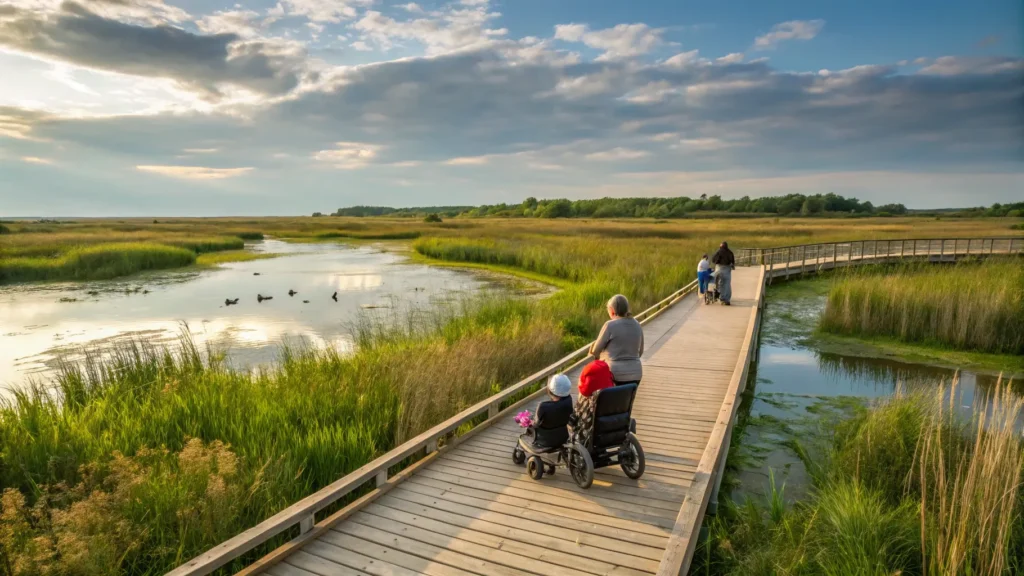
- Length: 0.5 miles (loop)
- Difficulty: Easy (fully accessible)
- Highlights: Wetland birds, amphibians, unique plants
- Surface: Elevated boardwalk
- Best For: Wheelchair users, strollers, all ages
- Special: Interpretive stations every 100 yards
Prairie Trail
- Length: 1.0 miles (loop)
- Difficulty: Moderate
- Highlights: Native prairie plants, butterflies, ground-nesting birds
- Surface: Mowed grass path
- Best For: Natural history enthusiasts, exercise walkers
- Peak Time: Summer for flowers, fall for birds
Hiking Trail
- Length: 2.5 miles (various loops)
- Difficulty: Moderate to challenging
- Highlights: Diverse habitats, quiet solitude, wildlife tracking
- Surface: Natural forest floor, some steep sections
- Best For: Experienced hikers, wildlife photographers
- Equipment: Sturdy shoes recommended
Nature Center & Exhibits
The 9,000-square-foot nature center serves as the heart of visitor experience at Bay Beach Wildlife Sanctuary:
Interactive Displays:
- Touch-screen exhibits about local ecosystems
- Hands-on animal artifacts (skulls, pelts, feathers)
- Interactive wetland diorama
- Live webcam feeds from rehabilitation areas
- Digital microscope station
Permanent Exhibits:
- Wildlife Hospital Gallery: See into the actual treatment areas
- Migration Station: Track bird movements in real-time
- Predator-Prey Display: Understanding natural relationships
- Conservation Success Stories: Local species recoveries
- Why Wildlife Gets Injured: Prevention education
Special Features:
- Living Classroom: Live animals used for educational programs
- Discovery Boxes: Hands-on activities for children
- Reference Library: Field guides and wildlife resources
- Theater: 50-seat space for presentations and films
- Kids’ Corner: Special area with books and activities
Observation Tower & Platforms
The sanctuary features several elevated viewing areas providing unique perspectives on wildlife activities.
Fox River Observation Tower
- Height: 30 feet above ground
- Views: Panoramic view of wetlands and river
- Best Times: Dawn and dusk for waterfowl activity
- Accessibility: Wheelchair accessible via ramp
- Features: Wind direction indicator, spotting scopes
Wetland Viewing Platform
- Location: End of boardwalk trail
- Height: 12 feet above marsh
- Highlights: Close waterfowl viewing, photography opportunities
- Seasonal Use: Best April-November
- Features: Built-in seating, interpretive scope
Fox River Platform
- Location: Along Fox River Trail
- Features: Fishing access, canoe/kayak launch
- Wildlife: Great blue herons, kingfishers, beavers
- Photography: Excellent sunrise location
Live Animal Programs
Bay Beach Wildlife Sanctuary: offers various programs featuring their ambassador animals.
Educational Presentations:
- Daily Programs: 11 AM and 2 PM (varies by season)
- Topics: Adaptations, conservation, rehabilitation process
- Duration: 30-45 minutes
- Featured Animals: Rotation of raptors, mammals, reptiles
Special Programs:
- Owl Calls: Nighttime owl experience (seasonal)
- Wildlife Photography Workshop: Tips and techniques
- Behind-the-Scenes Tours: See the wildlife hospital
- Junior Naturalist: Kids-only programs
Summer Schedule (Memorial Day – Labor Day)
- Monday: Mammal Monday
- Tuesday: Terrific Turtles
- Wednesday: Wild Wednesday (mixed program)
- Thursday: Raptors Rule
- Friday: Feathers and Flight
- Saturday: Special topic programs
- Sunday: Family programs
Schedule may change due to animal health, weather, or special events. Check the sanctuary’s website or call ahead to confirm.
Photography Hotspots
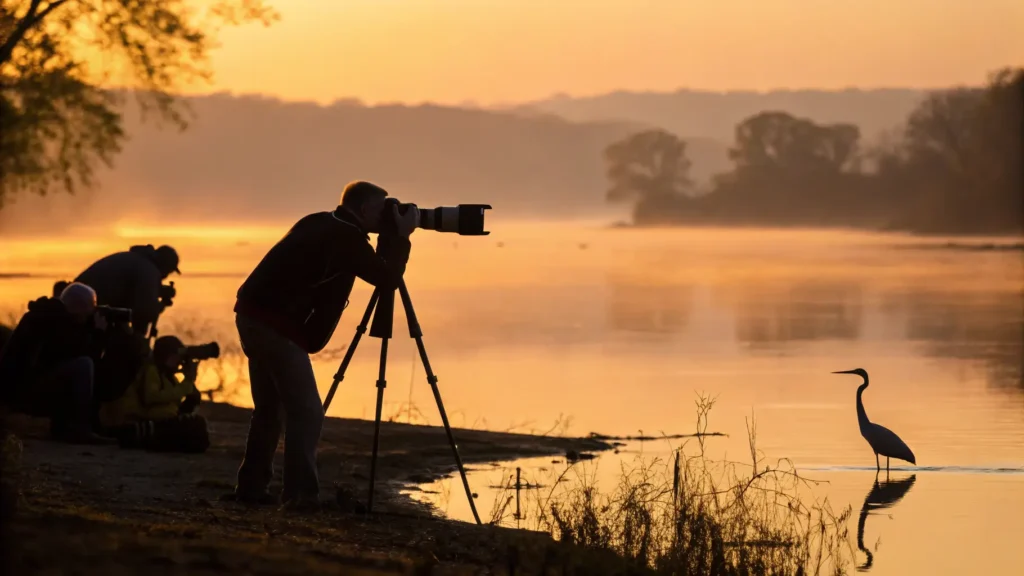
Bay Beach Wildlife Sanctuary: offers exceptional photography opportunities throughout the year.
Best Photo Locations
Fox River Sunrise Point
- Access: Fox River Trail, 0.5 miles from nature center
- Best Time: 30 minutes before and after sunrise
- Equipment: Tripod recommended
- Subjects: Waterfowl silhouettes, mist over water
Wetland Reflection Pool
- Location: Wetland Boardwalk midpoint
- Ideal Conditions: Calm, windless mornings
- Subjects: Perfect reflections of wildlife and vegetation
Prairie Butterfly Garden
- Season: June-September
- Equipment: Macro lens ideal
- Subjects: Native butterflies, wildflowers
Outdoor Exhibit Areas
- Best Light: Overcast days or golden hour
- Subjects: Ambassador animals in natural settings
- Ethics: Maintain respectful distance
Photography Tips for BBWS
- Arrive early for best light and active wildlife
- Bring a variety of lenses (wide for landscapes, telephoto for wildlife)
- Use a tripod for sharp images in low light
- Be patient – wildlife doesn’t follow schedules
- Respect all barriers and don’t disturb animals for photos
- Consider the background when composing shots
- Shoot in RAW format for maximum editing flexibility
Birdwatching Guide
Bay Beach Wildlife Sanctuary: is consistently rated among Wisconsin’s top birding locations.
By Season
Spring Migration (March-May)
- Peak: April 15-May 15
- Species: 30+ warbler species, vireos, thrushes
- Hotspots: Woodland Trail, early morning
- Rarities: Connecticut Warbler, Philadelphia Vireo
Summer Residents (June-August)
- Breeders: Red-winged Blackbirds, Yellow Warblers, House Wrens
- Waterfowl: Wood Ducks, Mallards, Blue-winged Teal
- Raptors: Red-tailed Hawks, Broad-winged Hawks
Fall Migration (August-November)
- Peak: September 15-October 15
- Features: More leisurely than spring, easier viewing
- Waterfowl: Peak diversity in October
- Sparrows: 12+ species in October
Winter Residents (December-February)
- Reliable Species: Chickadees, Nuthatches, Cardinals
- Occasional: Snow Buntings, Rough-legged Hawks
- Waterfowl: Ice-out determines species
Best Birding Spots
- Fox River Platform: Waterfowl year-round
- Woodland Trail entrance: Warbler hotspot in spring
- Wetland Boardwalk: Rails, bitterns, marsh birds
- Prairie areas: Bobolinks, Sedge Wrens (summer)
- Nature Center feeders: Winter species
Rare Bird Alert
- Check eBird for recent sightings
- Join the Bay Beach Birders Facebook group
- Sign up for WI-BIRD email list for state rarities
Amenities
Picnic Areas
Nature Center Patio
- Tables: 6 tables (seats 48)
- Features: Shade, electrical outlets, near restrooms
- Accessibility: Fully accessible
- Best For: Small groups, quiet dining
Fox River Picnic Area
- Tables: 8 tables (seats 64)
- Grills: 4 charcoal grills available
- Setting: River views, mature trees
- Parking: Dedicated parking area
Group Pavilion
- Capacity: 50+ people
- Reservations: Required for groups over 25
- Features: Electricity, nearby playground
- Cost: Donation suggested
Restroom Facilities
- Nature Center: Full facilities, family room, baby changing station
- Fox River Area: Vault toilets (seasonal)
- Wetland Area: Composting toilet facility
- All: ADA compliant
Additional Services
- Gift Shop: Nature-themed items, field guides, souvenirs
- Vending Machines: Beverages and snacks
- Information Desk: Staff available during nature center hours
- Lost and Found: Located at information desk
- First Aid: Staff trained in basic first aid
For Families & Kids
Bay Beach Wildlife Sanctuary: is exceptionally family-friendly, offering numerous activities designed specifically for children.
Kid-Friendly Features
Nature Playground
- Ages: 3-12 years
- Features: Natural play structures, sandbox, climbing areas
- Surface: Safety mulch
- Shade: Partial shade throughout day
- Nearby: Picnic tables for supervision
Discovery Packs
- What: Backpacks with hands-on activities
- Cost: Free with ID
- Contents: Magnifying glasses, field guides, activity sheets, collection containers
- Ages: Designed for different age groups
- Popular: Book in advance during peak season
Family Programs
Junior Naturalist Program
- Ages: 6-12 years
- When: Saturdays throughout summer
- Activities: Animal encounters, nature crafts, games
- Duration: 2 hours per session
- Registration: Required, fills quickly
Family Nature Nights
- Frequency: Monthly, spring through fall
- Time: 6:30-8:00 PM
- Features: After-hours tours, campfire programs, nocturnal animal sounds
- Age: All ages welcome
- Weather: Dress appropriately for season
Educational Activities for Children
Scavenger Hunts
- Availability: Year-round at information desk
- Types: Different versions for various ages
- Prizes: Completion sticker, small nature item
- Location: Can be completed on any trail
Touch Tables
- Location: Nature center lobby
- Items: Animal skulls, feathers, pelts, antlers
- Supervision: Required for younger children
- Educational: Volunteers provide information
Tips for Visiting with Kids
- Start with Nature Center: Indoor exhibits introduce concepts seen outside
- Bring snacks and water: Keeps energy levels up
- Use the buddy system: Older kids paired with younger ones
- Take breaks: Benches located throughout trails
- Expect questions: Kids naturally curious about everything
- Visit gift shop last: Avoid carrying purchases on trails
- Time visit appropriately: 2-3 hours typical for families with young children
Age-Specific Recommendations
Toddlers (2-4 years)
- Focus on short walks (Wetland Boardwalk best)
- Bring wagon for tired little ones
- Nature center touch table engagement
- Playground for energy release
Elementary Age (5-10 years)
- All trails manageable with rest stops
- Photography encourages observation
- Junior naturalist programs
- Discovery pack activities
Tweens/Teens (11+ years)
- Longer hiking trails challenge them appropriately
- Bird identification competitions
- Photography contests
- Volunteer opportunity introductions
Educational Programs & Volunteering
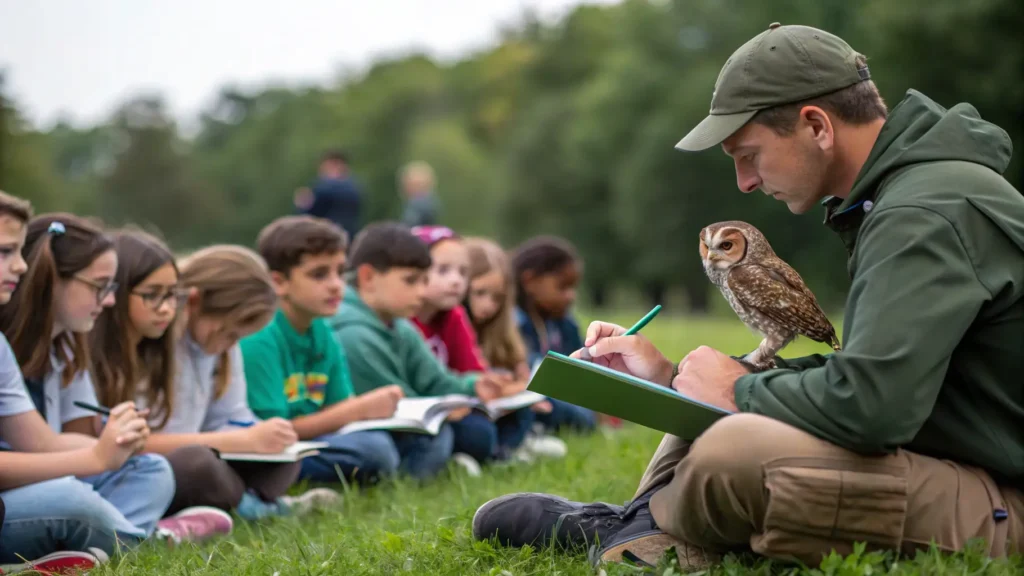
Educational Programs
Bay Beach Wildlife Sanctuary: offers extensive educational programming for all ages and interests.
School Programs
- Grades: Pre-K through 12th grade
- Options: On-site field trips, classroom visits, virtual programs
- Capacity: Up to 60 students per program
- Duration: 1-4 hours depending on program
- Topics: Ecosystems, adaptations, conservation, food webs
- Hands-on: Animal encounters included in most programs
- Standards: Aligned with Wisconsin Academic Standards
- Booking: Reserve 4-6 weeks in advance
Adult Education
- Naturalist Certification: 40-hour program over 8 weeks
- Master Naturalist: Advanced program for experienced volunteers
- Workshops: Photography, bird banding, plant identification
- Lecture Series: Monthly presentations by experts
- Field Trips: Guided expeditions to special locations
Special Interest Programs
- Butterfly Workshop: June-August, includes garden tour
- Mushroom Hunt: Fall programs with mycologist
- Winter Tracking: Reading stories in the snow
- Phenology Training: Climate change monitoring
- Wildlife Photography: Equipment recommendations and techniques
Volunteering Opportunities
Bay Beach Wildlife Sanctuary: relies heavily on dedicated volunteers who contribute thousands of hours annually.
Wildlife Care Volunteers
- Training: 20+ hours required, ongoing education
- Duties: Animal care, feeding, cleaning enclosures
- Commitment: Minimum 6 months, regular schedule
- Requirements: Background check, physical demands
- Ages: Typically 18+, some high school programs
Education Volunteers
- Roles: Program assistants, animal ambassadors, guides
- Training: 16-hour orientation plus specialty training
- Activities: Leading tours, handling education animals
- Flexibility: Various schedules available
- Ages: 16+ with adult supervision
Trail & Maintenance
- Season: Year-round, weather permitting
- Tasks: Trail repair, invasive species removal, construction
- Skills: Basic tools helpful but training provided
- Schedule: Flexible, project-based
- Groups: Welcome for large projects
Administrative Support
- Tasks: Office work, event planning, data entry
- Location: Nature center office
- Hours: Varies, often weekday daytime
- Skills: Computer literacy helpful
- Remote: Some opportunities available
How to Get Started
- Attend volunteer orientation (held monthly)
- Complete application and background check
- Participate in general training
- Choose area of specialization
- Complete specialized training
- Begin volunteering with mentor support
Volunteer Benefits
- Free training and continuing education
- Volunteer appreciation events
- Behind-the-scenes access
- Professional references
- Meaningful contribution to conservation
Research Opportunities
Advanced volunteers may participate in ongoing research projects:
- Bird Banding: Monitoring migration patterns
- Phenology: Recording seasonal changes
- Water Quality: Testing and monitoring protocols
- Wildlife Counts: Assisting with annual surveys
- Citizen Science: Contributing to national databases
Conservation & Rehabilitation Efforts
Bay Beach Wildlife Sanctuary’s conservation work extends far beyond public education, making tangible impacts on Wisconsin’s wildlife populations.
Wildlife Hospital Operations
The sanctuary operates one of Wisconsin’s premier wildlife medical facilities, treating over 2,000 animals annually.
Treatment Statistics
- Annual Admissions: 2,000-2,500 animals
- Success Rate: 65% released back to wild
- Common Injuries: Vehicle strikes, window collisions, fishing line entanglement
- Busiest Season: Spring (baby animals) and fall (migration injuries)
Medical Capabilities
- Surgery Suite: Full surgical capability including orthopedic procedures
- X-ray Equipment: Digital radiography system
- Laboratory: In-house blood work and diagnostic testing
- Rehabilitation Pools: For waterfowl recovery
- Flight Conditioning: Large flight cages for raptor conditioning
Staffing
- Veterinarian: Full-time wildlife veterinarian
- Technicians: 3 full-time rehabilitation staff
- Volunteers: 40+ trained wildlife care volunteers
- Interns: Summer internship program with veterinary students
Species Recovery Programs
Trumpeter Swan Restoration Bay Beach Wildlife Sanctuary: played a crucial role in reestablishing trumpeter swans in Wisconsin.
- Timeline: 1987-2010 intensive program
- Method: Hand-reared cygnets with crane costume rearing
- Success: Population grew from 0 to 200+ birds
- Current Role: Continued monitoring and occasional rehabilitation
Peregrine Falcon Recovery
- Historical: Instrumental in 1980s reintroduction
- Current: Monitoring urban nesting pairs
- Education: Public awareness about DDT recovery
- Release Sites: Provided numerous young falcons for release
Whooping Crane Partnership
- Role: Rehabilitation of injured birds
- Collaboration: Part of international recovery effort
- Experience: One of few facilities qualified to handle this endangered species
Research Initiatives
Migration Tracking
- Bird Banding: Over 10,000 birds banded annually
- Technology: GPS and satellite transmitters on select species
- Data Sharing: Contributing to national migration databases
- Discoveries: Several significant long-distance migration records
Climate Change Monitoring
- Phenology: 30+ year dataset on seasonal changes
- Range Shifts: Documenting species moving north
- Breeding Success: Monitoring impacts on reproduction
- Adaptation: Studying behavioral changes in wildlife
Pollinator Conservation
- Native Plant Gardens: Demonstration plots for community modeling
- Monarch Research: Migration timing and breeding success
- Bee Surveys: Documenting native bee populations
- Habitat Creation: Best practices for pollinator gardens
Environmental Protection
Habitat Management
- Controlled Burns: Maintaining prairie ecosystems
- Invasive Species: Ongoing control of purple loosestrife, garlic mustard
- Wetland Restoration: Converting marginal agricultural land
- Forest Management: Creating diverse age structure
Water Quality Protection
- Fox River Monitoring: Regular water quality testing
- Stormwater Management: Green infrastructure demonstration
- Agricultural Outreach: Working with local farmers
- Research: Studying impacts of urban runoff
Educational Impact
Conservation Messages
- Wildlife-Vehicle Collisions: Prevention education and solutions
- Backyard Habitat: Encouraging wildlife-friendly landscaping
- Pollution Prevention: Focusing on plastic, chemicals, and oil
- Sustainable Living: Connecting personal choices to wildlife health
Community Engagement
- Schools: Reaching 15,000+ students annually
- Adults: 500+ adults in naturalist programs yearly
- Volunteers: Training conservation advocates
- Media: Regular public outreach through various channels
Success Stories
Individual Animal Stories
- E2: Bald eagle released after fracture repair, tracked for 5 years
- Phoenix: Great horned owl with permanent eye injury, now education ambassador
- Luna: Gray wolf pup orphaned, raised and successfully released
- Hope: Trumpeter swan hit by car, complete recovery after 6 months
Population Victories
- Bald Eagles: From 0 nesting pairs (1970s) to 20+ pairs in region
- Wood Ducks: Population recovery through nesting box programs
- Native Plants: Restoration of 50+ acres of tallgrass prairie
- Water Quality: Measurable improvements in Fox River health
Nearby Attractions & Amenities
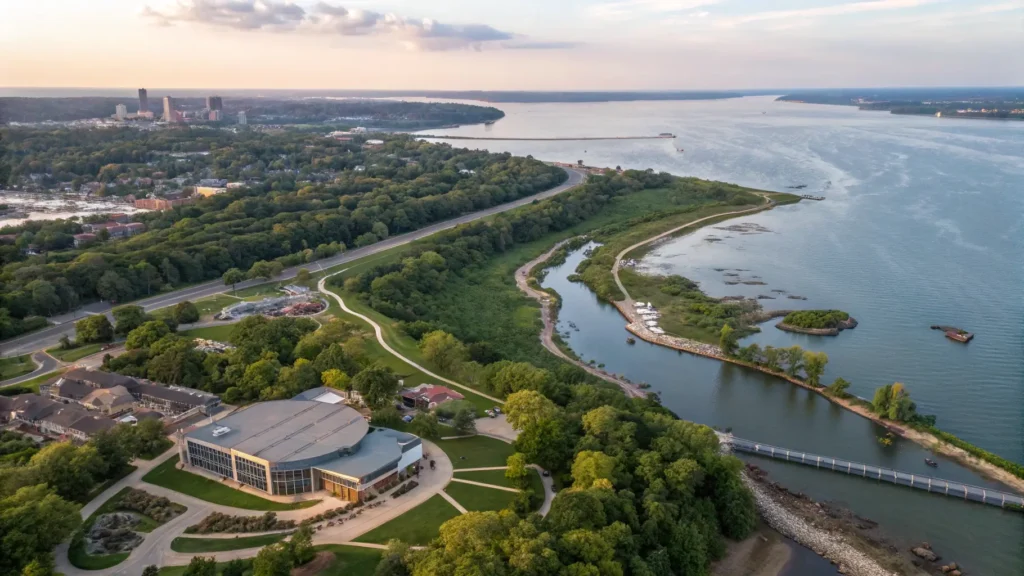
Green Bay offers numerous attractions that complement a visit to Bay Beach Wildlife Sanctuary:
Natural Areas & Parks
Bay Beach Amusement Park
- Distance: Adjacent to wildlife sanctuary
- Features: Historic rides, beach access, arcade
- Best For: Families after wildlife visits
- Season: Memorial Day – Labor Day
- Parking: Shared with wildlife sanctuary
NEW Zoo & Adventure Park
- Distance: 15 minutes north of sanctuary
- Highlights: Prairie dogs, ropes course, zip lines
- Combo: Many visitors do both sanctuaries in one day
- Season: Year-round with seasonal hours
Green Bay Botanical Garden
- Distance: 20 minutes northwest
- Features: Themed gardens, visitor center, events
- Complement: Perfect pairing with wildlife viewing
- Season: April – October (some winter displays)
Wequiock Falls County Park
- Distance: 10 minutes southwest
- Features: Waterfall, hiking trails, picnic areas
- Best Time: Spring snowmelt, fall colors
- Difficulty: Easy to moderate trails
Lodging Options
Near Bay Beach Wildlife Sanctuary:
Hampton Inn & Suites Green Bay
- Distance: 3 miles from sanctuary
- Amenities: Indoor pool, hot breakfast, pet-friendly
- Rate Range: $120-$180/night
- Bonus: Views of Green Bay
Aloft Green Bay
- Distance: 5 miles from sanctuary
- Style: Modern, boutique hotel
- Features: Rooftop bar, tech-savvy rooms, fitness center
- Rate Range: $140-$200/night
Budget-Friendly Options:
Motel 6 Green Bay
- Distance: 8 miles from sanctuary
- Features: Pet-friendly, basic amenities
- Rate Range: $60-$90/night
- Best For: Budget-conscious families
Microtel Inn & Suites
- Distance: 6 miles from sanctuary
- Amenities: Continental breakfast, indoor pool
- Rate Range: $80-$110/night
Camping Options:
Bay Shore County Park
- Distance: 5 minutes from sanctuary
- Sites: 55 campsites, RV-friendly
- Amenities: Showers, restrooms, beach access
- Rates: $25-$35/night
Brown County Reforestation Camp
- Distance: 15 minutes from sanctuary
- Features: Rustic cabins, hiking trails
- Best For: Groups, outdoor enthusiasts
- Rates: $40-$60/night
Dining Recommendations
Near Sanctuary (within 5 miles):
Shipwreck Lagoon
- Cuisine: American, seafood
- Distance: Adjacent (Bay Beach Amusement Park)
- Specialties: Fish fry, burgers, ice cream
- Atmosphere: Casual, family-friendly
- Season: Memorial Day – Labor Day
Riverside Ballroom
- Cuisine: American, banquet facility
- Distance: 2 miles from sanctuary
- Features: Historic venue, Sunday brunch
- Best For: Special occasions, large groups
- Reservations: Recommended
Titletown Brewing Company
- Cuisine: Pub fare, craft brewery
- Distance: 8 miles from sanctuary (downtown Green Bay)
- Specialties: Local brews, Wisconsin classics
- Atmosphere: Historic converted train depot
- Hours: Lunch through late evening
Captain’s Walk Winery
- Cuisine: Wine bar, light fare
- Distance: 10 miles from sanctuary
- Features: Wisconsin wines, cheese boards
- Setting: Historic waterfront building
- Best For: Romantic evening, adult groups
Quick Bites & Cafes
Cranky Pat’s Pizza
- Distance: 3 miles from sanctuary
- Specialties: Wood-fired pizza, local institution
- Atmosphere: Casual, dive bar feel
- Hours: Dinner only (4 PM onwards)
Green Bay Coffee & Co.
- Distance: 7 miles from sanctuary
- Features: Local roaster, pastries, light lunch
- Best For: Morning fuel before sanctuary visit
- Hours: 6 AM – 3 PM daily
Nic’s Restaurant
- Distance: 5 miles from sanctuary
- Cuisine: Classic American diner
- Features: Generous portions, local favorite
- Best For: Hearty breakfast after early morning birding
- Hours: 6 AM – 3 PM
Shopping
Green Bay Distillery Shop
- Distance: 8 miles from sanctuary
- Products: Local spirits, cocktail mixes, gifts
- Tours: Distillery tours available
- Best For: Adults seeking local products
The Automobile Gallery
- Distance: 6 miles from sanctuary
- Features: Classic car showroom, unique gifts
- Interest: Vintage memorabilia, automotive items
- Hours: Tuesday – Saturday
Historical & Cultural Attractions
National Railroad Museum
- Distance: 10 miles from sanctuary
- Highlights: Historic locomotives, train rides
- Combo: Great rainy-day alternative
- Season: Year-round, outdoor exhibits seasonal
Heritage Hill State Historical Park
- Distance: 15 miles from sanctuary
- Features: Living history, historic buildings
- Programs: Costumed interpreters, special events
- Best Time: Summer for full programming
Hazelwood Historic House
- Distance: 12 miles from sanctuary
- Architecture: Greek Revival mansion
- Tours: Guided tours available
- Interest: Local history, period furnishings
Visitor Tips & Hidden Gems
Insider Tips
Early Morning Secrets
- Arrive 15 minutes before opening for prime parking spots
- Staff often feed outdoor exhibit animals at 7:30 AM
- The first hour offers the most active wildlife behavior
- Photography conditions are best in the hour after sunrise
Seasonal Hidden Gems
- Spring: Check behind nature center for migrating warblers
- Summer: Butterfly garden peaks between 10 AM – 2 PM
- Fall: Fox squirrels bury nuts near prairie trail entrance
- Winter: Cross-country ski trails offer unique perspectives
Photography Secrets
- The north side of the wetland boardwalk has best morning light
- Overcast days create ideal conditions for photographing white animals
- The old apple tree near the Fox River attracts unusual bird species
- Snow provides striking contrast for winter wildlife photography
Lesser-Known Areas
The Secret Prairie
- Location: Beyond the main prairie trail loop
- Access: Unmarked path near trail mile marker 0.7
- Features: Undisturbed native plants, rare butterflies
- Best Time: Late summer evenings
- Note: Easy to miss, look for worn footpath
Turtle Log
- Location: Fox River, upstream from main platform
- Features: Best spot for painted turtles basking
- Peak Time: Mid-morning, sunny days
- Season: May through September
- Tip: Bring binoculars for close viewing
Owl Roost
- Location: Large oak near trail intersection (Woodland/Fox River)
- Species: Barred owl frequently roosts here
- Best Time: Late afternoon in winter
- Identification: Look for whitewash on tree trunk below
- Caution: Maintain distance to avoid disturbing
Staff & Volunteer Insights
From Sarah, Head Naturalist (12 years at BBWS): “The best wildlife viewing happens when visitors slow down. Spend 10 minutes sitting quietly on any bench, and you’ll see three times more wildlife than rushing through trails.”
From Tom, Wildlife Rehabilitator (8 years experience): “Most people miss the small things. Watch for chipmunk highways – they use the same routes daily. Follow these ‘paths’ with your eyes for interesting discoveries.”
From Maria, Volunteer Coordinator (15 years volunteering): “The nature center’s second floor has windows overlooking the Fox River that most visitors never explore. Great spot for quiet observation on busy days.”
From Dr. Johnson, Sanctuary Veterinarian: “Our 2 PM animal programs rotate based on which animals are most active that day. The scheduled animal might change, but you’ll always see the most engaging presentation.”
Hidden Facilities
Quiet Study Room
- Location: Nature center, second floor
- Features: Reference library, comfortable seating
- Best For: Research, quiet breaks, nursing mothers
- Hours: Same as nature center
Emergency Weather Shelter
- Location: Along Fox River Trail, mile 0.8
- Features: Three-sided shelter with bench
- Use: Sudden weather changes, rest stop
- Note: Not climate-controlled
Unique Programs & Events
Full Moon Tours
- Frequency: Monthly, weather permitting
- Duration: 90 minutes
- Features: Nocturnal sounds, night vision adaptation
- Registration: Required, limited to 15 participants
- Special: Often includes hot chocolate
Dawn Chorus Walks
- Schedule: Weekends in May
- Start Time: 5:30 AM (before sunrise)
- Focus: Bird identification by sound
- Equipment: Provided penlight, identification cards
- Bonus: Continental breakfast after walk
Migration Banding Demos
- Season: Spring and fall migration peaks
- Days: Select Saturdays
- Process: Watch birds being banded, learn about research
- Educational: Hands-on science demonstration
- Advance Notice: Announced via email list
Local Knowledge
Weather Patterns
- Morning fog common March-April, lifts by 9 AM usually
- Summer thunderstorms typically arrive 2-4 PM
- Winter: Dress warmer than forecast – open areas feel colder
- Ice fishing enthusiasts know when Fox River will freeze
Wildlife Behavior
- Beavers most active at dawn and dusk
- Feeding time for outdoor exhibits varies with season
- Migrating birds follow power lines – look up while walking
- Deer bed down in tall grass, look for matted areas
Money-Saving Tips
Free Resources
- Use library binoculars instead of renting
- Download free bird identification apps before visiting
- Join mailing list for advance notice of special free events
- Many programs offer reduced rates for students and seniors
Pack Smart
- Bring reusable water bottles (filling stations available)
- Pack snacks to avoid concession prices
- Wear layers to avoid gift shop clothing purchases
- Bring field guides from local library
Making the Most of Your Visit
Time Management
- 2-hour visit: Nature center + one trail
- Half-day visit: Nature center + two trails + program
- Full day: All trails + programs + photography time
- Multi-day: Different seasons offer unique experiences
Visit Combinations
- Wildlife sanctuary + Bay Beach Amusement Park = full family day
- BBWS in morning + Green Bay Botanical Garden in afternoon
- Dawn birding + afternoon at NEW Zoo
- Winter visit + heated indoor attractions for balance
Special Opportunities
- Guided group tours available for 10+ people
- School groups get special educational rates
- Birthday party packages include private program
- Corporate team-building activities can be arranged
FAQ Section
General Visiting Questions
Q: Is Bay Beach Wildlife Sanctuary really free?
Yes, completely free! Parking, trail access, and most programs are free. Some special workshops may have a small fee, but regular admission is always free.
Q: How long should I plan for a visit?
Most visitors spend 2-4 hours. Plan extra time during migration seasons or if participating in programs.
Q: Do I need to make reservations?
No reservations needed for general admission. Some special programs require advance registration.
Q: Can I bring my dog?
Pets are not allowed except for service animals. This protects both wildlife and pets.
Q: What’s the best time of day to visit?
Early morning (first hour after opening) typically offers the best wildlife viewing, though afternoon programs are popular.
Wildlife & Photography Questions
Q: What wildlife am I guaranteed to see?
While wildlife sightings can never be guaranteed, common species include deer, waterfowl, and various songbirds. Outdoor educational animals are always viewable.
Q: When is the best time for bird migration?
Spring peak: April 15-May 15; Fall peak: September 15-October 15. Fall migration lasts longer but spring is more intense.
Q: Can I feed the animals?
No, feeding wildlife is prohibited for their health and safety. It can make animals sick and potentially aggressive.
Q: What camera equipment should I bring?
A zoom lens (200mm minimum) is helpful for wildlife. Binoculars are essential and can be rented for $5.
Facilities & Accessibility
Q: Are wheelchairs available?
The sanctuary is largely wheelchair accessible. Wheelchairs aren’t provided, but staff can arrange golf cart tours for mobility-impaired visitors with advance notice.
Q: Where can I eat on-site?
No restaurant on-site, but picnic areas are available. Vending machines in nature center offer light snacks.
Q: Is there WiFi?
Free WiFi available in the nature center. Cellular service can be spotty on some trails.
Educational Programs
Q: Are programs suitable for all ages?
Most programs are designed for general audiences. Special children’s and adult-only programs are clearly marked.
Q: Can I volunteer without experience?
Yes! All volunteers receive training. Various opportunities exist for different skill levels and interests.
Q: Do you offer school field trips?
Yes, extensive educational programs for all grades. Book 4-6 weeks in advance, especially for spring and fall visits.
Weather & Seasons
Q: Is the sanctuary open in bad weather?
Yes, though some outdoor exhibits may be closed. Nature center provides indoor activities during severe weather.
Q: What should I do if I encounter an injured animal?
Don’t approach! Find a staff member or call the sanctuary immediately. They’re trained to handle wildlife safely.
Q: Do programs run in winter?
Yes, many programs continue year-round. Winter offers unique opportunities like tracking and winter ecology programs.
Special Situations
Q: Can I bring a large group?
Large groups (15+) should contact the sanctuary in advance for best experience. Special programs may be available.
Q: What happens to animals that can’t be released?
Animals with permanent disabilities that prevent wild release become permanent residents and often serve as educational ambassadors.
Q: Can I donate to the sanctuary?
Yes! Donations are always appreciated and support wildlife care, education, and facility maintenance.
Q: How can I stay updated on events and wildlife sightings?
Join the mailing list, follow social media accounts, or check the website regularly for updates.
Conclusion
Bay Beach Wildlife Sanctuary: represents far more than just another nature center – it’s a conservation success story in action, a healing haven for wildlife, and a gateway to understanding our natural world. Whether you come for the stunning photography opportunities, world-class birding, family-friendly trails, or educational programs, you’ll leave with a deeper appreciation for Wisconsin’s incredible wildlife.
The sanctuary’s unique combination of active wildlife rehabilitation, diverse habitats, and comprehensive educational programming creates an experience you simply can’t find elsewhere. From watching a bald eagle soar overhead to observing the delicate process of wildlife rehabilitation through the nature center’s viewing windows, every visit offers something new to discover.
As you plan your visit to Bay Beach Wildlife Sanctuary: remember that you’re not just a tourist – you’re becoming part of a conservation community that has worked tirelessly for nearly a century to protect and preserve Wisconsin’s wildlife. Your visit supports ongoing rehabilitation efforts, educational programs, and habitat preservation that benefit countless wild animals.
Whether this is your first visit or you’re a longtime friend of the sanctuary, we hope this guide helps you make the most of your time at this remarkable place. Take your time, observe quietly, ask questions, and prepare to be amazed by the resilience and beauty of the natural world.
Call to Action
Ready to experience Bay Beach Wildlife Sanctuary: for yourself? Here’s how to make it happen:
Plan Your Visit:
- Check current hours and any special events at Wisconsin DNR’s Bay Beach page
- Follow Bay Beach Wildlife Sanctuary: on social media for recent wildlife sightings and program updates
- Sign up for their email newsletter to receive program announcements and seasonal highlights
Share Your Experience:
- Tag your photos with #BayBeachWildlife to share with other nature enthusiasts
- Write a review on TripAdvisor or Google to help other visitors plan their trips
- Consider volunteering to become part of the sanctuary’s conservation mission
Support the Mission:
- Visit the gift shop to support sanctuary operations
- Consider making a donation to help fund wildlife rehabilitation and education programs
- Spread the word about this amazing Wisconsin gem to friends and family
Bay Beach Wildlife Sanctuary: is waiting to share its natural wonders with you. Come discover where wildlife thrives, conservation happens, and every visit contributes to a better future for Wisconsin’s incredible wildlife.
Safe travels, and happy wildlife watching!

